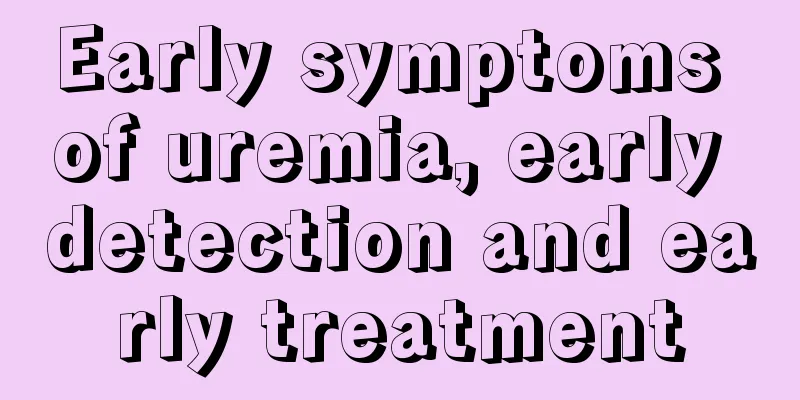Early symptoms of uremia, early detection and early treatment

|
Uremia is a serious disease that occurs after renal failure. It is a disease that is very harmful to the patient's health. In the early stages, symptoms such as loss of appetite, drowsiness, edema, and anemia will appear. Early detection and early treatment can prevent a series of complications. 1. Symptoms and Signs Uremia actually refers to the inability of the human body to produce urine through the kidneys to excrete metabolic waste and excess water from the body, causing poisoning. Modern medicine believes that uremia is a series of complex syndromes caused by the disorder of biochemical processes in the body after the loss of renal function. Rather than an independent disease, it is called renal failure syndrome or simply renal failure. The term was coined by Piorry and Heritor in 1840 after they described renal failure. Common symptoms of uremia include loss of appetite, dullness of senses, emotional indifference, drowsiness, decreased urine volume, facial and lower limb edema, anemia, itchy skin, muscle cramps, and sometimes restlessness and even epilepsy. Symptoms of uremia can develop slowly and remain undetected for a long time. Acute renal failure can occur within a few days, with obvious symptoms of uremia. Uremic syndrome can be varied, and not all symptoms are necessarily present. 2. Disease Diagnosis 1. Blood examination: ① Increased urea nitrogen and creatinine. ②Hemoglobin is generally below 80g/L and can drop to 20-30g/L in the terminal stage, which may be accompanied by thrombocytopenia or elevated white blood cells. ③ Arterial blood gas, acid and alkali determination: In the late stage, the pH value often decreases, AB, SB and BE all decrease, and PaCO2 shows a compensatory decrease. ④Plasma protein may be normal or decreased. ⑤ Abnormalities may be found in electrolyte measurements. 2. Urine examination ① Changes in urine routine may vary depending on the underlying cause. There may be proteinuria, red and white blood cells or casts, or the changes may not be obvious. ② Urine specific gravity is mostly below 1.018, and is fixed between 1.010 and 1.012 in uremia. The amount of urine at night is greater than that during the day. 3. Renal function test ① Glomerular filtration rate and endogenous creatinine clearance rate are reduced. ②Phenol red excretion test and urine concentration and dilution test were both reduced. ③The pure water clearance rate measurement is abnormal. ④Nuclear renogram, renal scan and scintigraphy can also help understand renal function. 4. Other examinations: Urinary system X-ray or angiography, renal puncture biopsy, which are helpful for diagnosing the cause. The diagnosis can be confirmed based on the history of chronic kidney disease, relevant clinical manifestations, and urine and blood biochemical tests. The degree of renal function abnormality can be divided into three stages according to the levels of glomerular filtration rate (GFR), blood urea nitrogen (BUN) and blood creatinine (cr): 1. Compensatory stage of renal insufficiency: GFR is between 50-70ml/min, blood BuN>7.14>8.93mmol/L, blood Cr>132177umol/L, with symptoms such as mild fatigue, loss of appetite and varying degrees of anemia. |
<<: Uremia diet, dietary health care needs to be understood
>>: What food is better for radiation protection?
Recommend
What is the reason for repeated closed comedones on the face?
In life, we all know that closed comedones are di...
Are there no symptoms for early lung cancer? Three symptoms of early lung cancer are easy to ignore
Patients with early lung cancer have symptoms, bu...
What are the symptoms of bladder cancer in the early stages?
Bladder cancer is the most common malignant tumor...
How can patients with nasopharyngeal carcinoma prevent recurrence
Various diseases emerge in our lives, often catch...
How to prevent and treat pancreatic cancer in daily life
80% of pancreatic cancer occurs in the head of th...
What to do with throat stones
As the name suggests, throat stones are stones gr...
There is inflammation and swelling on the mouth
There are often problems with the health of the m...
Eyelash shedding cycle
Eyelashes are a very critical part. They cannot b...
Can't people with thyroid cancer eat seafood?
Patients with thyroid cancer can generally eat se...
What is the cause of leg pain
There is a big lump on my leg, which is very pain...
How to maintain the tattoo after washing
Nowadays, more and more young people are getting ...
Tingling sensation in buttocks
Now with the development of technology, more and ...
How does traditional Chinese medicine treat gastric cancer? Regulate through three methods
Traditional Chinese medicine plays a very positiv...
The best treatment for pinworm disease
Many mothers find that their children cry at nigh...
What are the main daily medications for teratoma patients
Teratoma is a common disease in women. It is a be...









